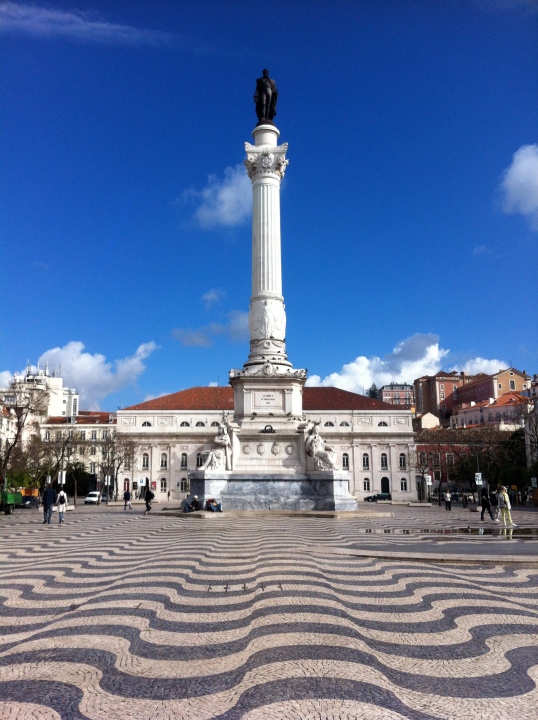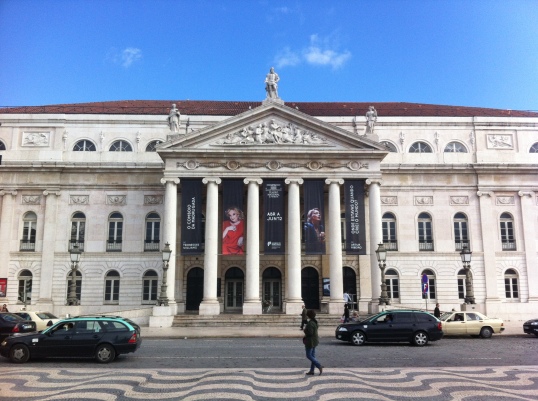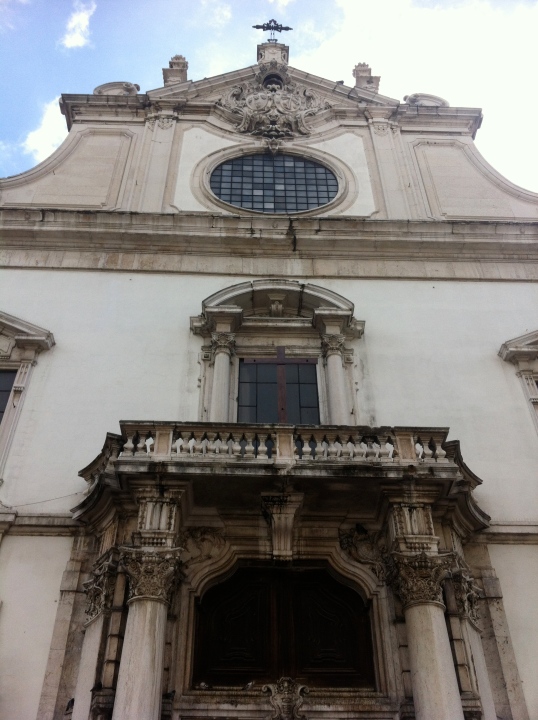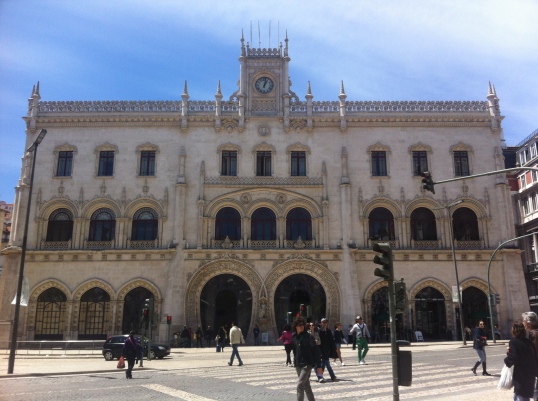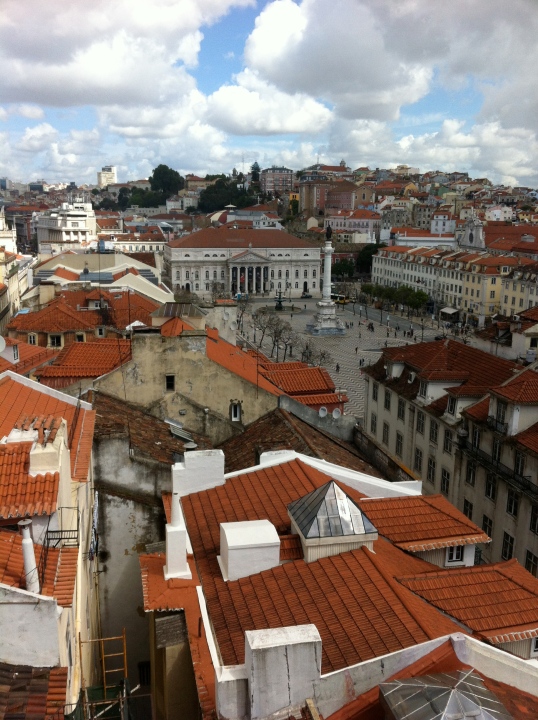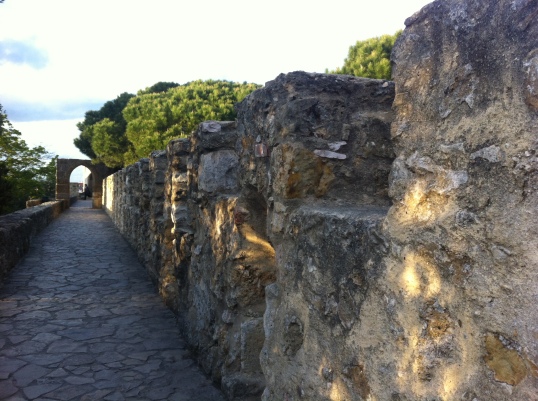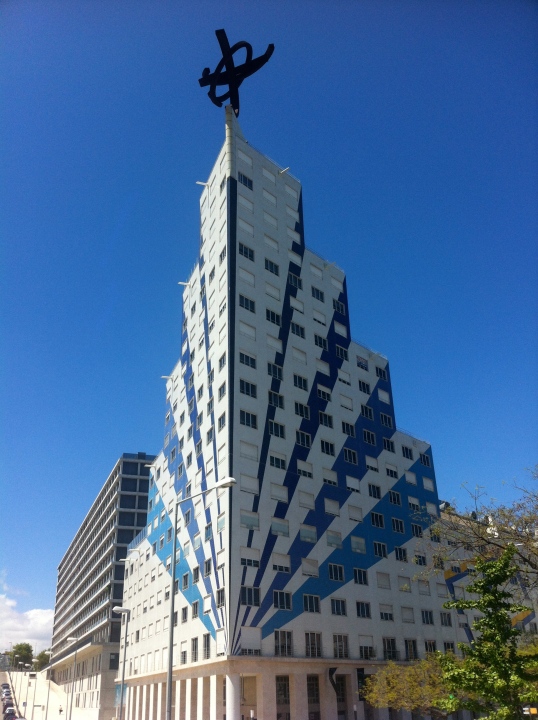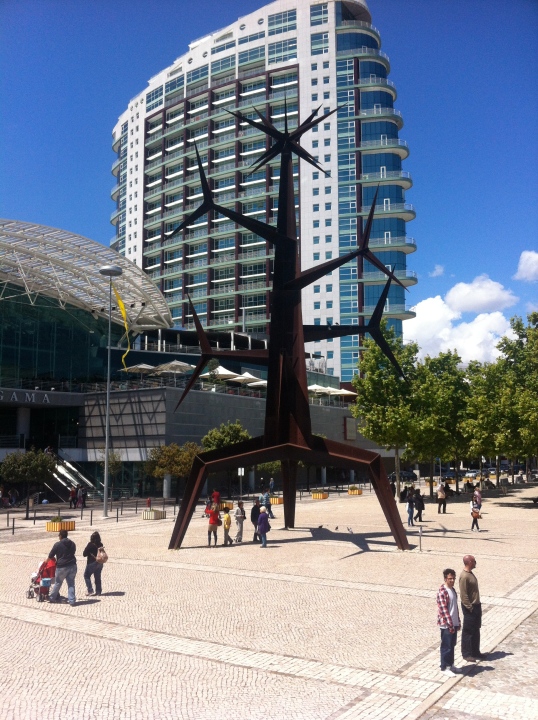Three Days in Lisboa
When I spoke to people in Porto and told them I was going to Lisbon, the common response was “You’ll like Porto better;” I got the same response in Lisbon when I told them I was staying in Porto.
As with all things, it’s a question of difference. When I get around to posting about Porto next week, you’ll see why I love it there.
This post, however, is about Lisbon, and I can say that I did love the city.
I can also tell you that 3 days is not nearly enough time to enjoy Lisbon.

South side of Praca da Figueira, the Castelo de Sao Jorge in the background, on the night of the “Supermoon”
Lisbon, or the site where modern-day Lisbon stands, has been inhabited for thousands of years. Indeed, Lisbon itself has been here since 1147, making it one of the oldest cities in Europe. Not much of the ancient city remains, as a major earthquake destroyed the city in the 1700s. Lisbon was rebuilt according to the principles of modern city development, and as such, downtown area, or Baixa, is on a grid system. There are still parts of the city, such as Alfama, which retain its medieval charm.
Walking Tour
Since I had very little time to see the city, I decided the best way was to take part in a walking tour. I’ve had great luck with walking tours throughout the Big Trip, and Lisbon’s was no exception. I found out about the walking tour at one of the many Tourismos in the city (staying in Baixa was an advantage – more of that later), and I ended up on The Original Lisbon Walk by Inside Lisbon. It was a bit slow to start, but my tour guide, Martha, was quite lovely and knowledgeable. Turned out that, of the 10 people on our tour, 6 of us were from Toronto, and the Brit and Aussie on the tour had lived in Vancouver. Canada represent!
The tour started off in Praca Rossio, the main square in Lisbon. It’s a central point in the city, with a statue to Don Pedro IV, who was king of Portugal and Emperor of Brazil, as well as the National Theatre. The tile work in the square (of which there is a lot *everywhere* in Portugal) is made to represent the ocean, which at one point came up all the way to where the square is today.
Interstingly, the square was also the site of the Inquisition in Portugal, although nothing remains of the church.
Next up was the Igreja de Sao Domingos, which is just off the Rossio and Praca de Figueira. It’s one of the many Baroque churches in Lisbon, and is quite beautiful.
The church, however, has a chequered past: it was here that thousands of Jews were killed in the middle ages. In the square that links the church to Rossio, there have bene erected monuments to these people, as well as a public apology on behalf of the people of Lisbon.
We then walked along to Praça dos Restauradores,a square that celebrates the restoration of Portuguese independence. It is at the foot of Avenida da Liberdade, a wide avenue that is touted as a “mini Champs Elysees.”
There are three things of note on Restauradores: The Eden Cinema, which is a beautiful Art Deco cinema, which has now been converted to a hotel; the second, just below the square is the Rossio train station, which is in the Manueline style, a style I had never heard of. It’s also quite beautiful, and very different from any architecture I’ve seen before.
The final edifice of note is the Obelisk in the middle of the square, on which is listed the major battles of the Portuguese Restoration War. It’s also quite stunning.
From there, we climbed to the Chiados neighbourhood, which is up the mountain from Baixa. There is an Elevator that goes from Baixa to Chiados, but a) it costs money and b) you can just walk from where we were. So walk we did.
We walked into Carmo Square, which is the site of the old Carmo Convent, the church of which is now in ruins. The square is also one of the locations of the 1975 Republican revolution, a bloodless coup that turned Portugal from a dictatoriship to a republic. The Elevator is just beside the old church (now an Archaelology museum), and from there you get some beautiful views of the city. The best part is that the platform is free to go on, and it’s only 1E50 if you want to go to the top level.
After coffee and pastries, we headed back into Rossio to catch the tram up to Sao Jorge and into Alfama.
Sao Vicente is (one of?) the Patron Saint of Lisbon, and the symbol of Lisbon is the boat from his legend. It stands in a square just outside the walls of Sao Jorge, where the main entrance is, which would have been nice for me to clue into when I went looking to get in there later on that day… but I digress.
From here we walked down into Alfama, and it was quite the maze of streets and sqaures. As one of the girls on the tour pointed out, our guide could easily have abnadoned us and we’d ahve been screwed. Luckily, she did not.
It was a fantastic walk down to the main streets through the streets, there was so much to see, and I didn’t take a lot of pics. Oh well. I have the images in my mind.
From there we visited the Se, which is the main Cathedral in Lisboa.
The Se is an impressive building, and has Romanesque, Baroque and Gothic elements. The Facade is Romanesque, and you get a fantastic view of it as you come up the street from Baixa.
The interior is beautiful simplicity, which I am really starting to appreciate in Romanesque architecture.
The really cool thing about the Se do Lisboa is that the cloisters are open to the public, and in the courtyard of the cloisters is an archaeological dig. For 2E, you can go into the cloisters and take a walk around.
There, you can see walls, sidewalks and stairs from the Roman period. Some of the wall paint remains.
The cloisters are built in a Gothic style, and as with most cloisters, you can feel the peace and quiet that monks and nuns would wish for in their devotions and metitations. These cloisters are, I found, a bit darker than some I have visited, likely because there doesn’t seem to be a lot of exposure to the outdoors.
Just below the Se is the Church of Saint Anthony, the *other* patron Saint of Lisbon. Saint Anthony is usually associated with Padua, where he is buried, but he was born and raised in Lisbon, apparently on the site where his church now stands. Every year, apparently, the municipality springs for several couples to be married in the Cathedral on Saint Anthony’s day. Also, apparently, in Lisbon St. Anthony is depicted as a boy or young man, whereas in Padua, he is depicted as an old man.
We finished our tour in Praca do Comercio, which is also known as Terreiro do Paco, or Palace Square. This enormous public square, which is bordered on three sides by the old Palaces, and on the other by the River Tagus, used to be the ceremonial entry to the city from the river, and visitors were received into the city through the large ceremonial arch that dominates the square. In the centre of the square is a statue of King Jose I, as this was once a royal square. Most of the buildings that surround the square are now government offices, but as you can see from the photo above, there is work afoot to make the square more accessible and user friendly. New tram lines and roads, as well as shops and restaurants in the arcades of the buildings are under construction.
Castelo do Sao Jorge
I love castles. That should be obvious by now. And this one has, so far, been the best one. Castelo Sao Jorge, or Saint George Castle, sits atop one of the hills in Lisbon. Yes, Saint George is the Patron Saint of England, but Joao I named it after him in honour of his wife, and English princess. The castle itself is moorish in origins and dates back to the early middle ages.
I’m not sure why I look so… perplexed.
This is, I think, the most in-tact castle I’ve visited, with much of the ramparts and keeps still in tact. It was awesome to be able to walk the perimeter of the old ramparts and get up into the turrets and whatnot. And the views of the city from the castle are breathtaking. I was looking into the west at sunset so it was hard to tell, but i think you can see the ocean from there.
Part of the castle grounds are being dug up for archaeological purposes, as it’s known that the hill has been inhabited for millenia. The museum on the grounds has artifacts that date back to roman times. The ruins are of two times, some Roman, and some Islamic.
I always get a bit… emotional? when I visit ruins, especially when they are fairly in tact. It’s very humbling to know that, thousands of years ago, people were going about their daily lives on the place that you are now standing, and there’s something more poignant about the fact that all that remains are a few stones, a wall, a walkway, a well. Makes you wonder what we’re leaving behind us now.
There were peacocks roaming the grounds. It was weird. I wonder if they’re natural to the area.
Yellow Bus
I found out about the Yellow Bus tours in Porto, which I took because it was cheaper, and you got free public transport on the city lines for the duration of the ticket as well as the tourist bus. I also liked that, apparently, you got 25% off Yellow Bus tours in other cities, like Lisbon.
This, however, was not the case. Apparently that only works if you buy a single bus tour, not a package. Curses.The two-tour combo pack, for 48 hours, was 19E.
At any rate, the tours were good overviews of the city, and I got introduced to two cool areas: Parque das Nacoes and Belem.
Parque das Nacoes
Lisbon hosted Expo 98, and this neighbourhood is what came out of it. Ultra-modern buildings, a grand avenue, fountains, exhibition and commercial space and an aquarium and mall are just some of the things that came out of the expo. It was a very beautiful modern area.
One of the legacy projects is the beautiful Gare do Oriente, the eastern main station in Lisbon. I recall going through it on my way into Lisbon, and thinking how beautiful the roof is.
On the bus tour, I also got to see:
Belem
West of the city centre on the River Tagus is Belem, now a suburb, but it used to be a village in its own right, and one of the first points of defense for Lisbon. There is a monastery, cultural centre, and a quaint little downtown area. I have ot admit, I was in a complete rush visiting here (as it was late afternoon and I had to catch a train) but here are the highlights:
This is the Pasteis de Belem store, where they make Pasteis de nata, which are custard tarts:
and they are all kinds of awesome. This store is apparently *the* place to get these pastries, and they are so famous from this store that they are called pasteis de Belem, and just pasteis de nata everywhere else. I dig.
On the edge of the river is this enormous statue which honours the explorers and supporters who helped expand Portugal’s empire in the 16th and 17th centuries.
The Belem Tower, another UNESCO World Heritage Site, is a Manuline tower that sits just off the shore of the Tagus, and was built to be the first line of defence of Lisbon.
The Jeronimos Monastery, also in the Manuelite style, dates back the the 1500s. It is a World Heritage site along with the Tower of Belem.
Accommodation
I lucked out huge with this one. Using Hostelworld (which is, by the way, an awesome site), I found the Pencao Prace da Figueira, which is right in Praca da Figueira in Baixa. It was cheap (only 30E a night), clean, and central, and although the beds were really hard, it was an awesome place to stay.
Getting around
If you stay anywhere in the city centre, you can walk pretty much anywhere you might want to go. You might be walking uphill, but it’s doable. There is a very good Metro, which I took from the train station to the Pencao, but I didn’t really use it much after that. There are also trams, one of which I took to Belem, and some of which are heritage trams that act as tourist trams. All in all, though, it was very inexpensive (a daypass on the Metro was 5E) and very convenient.
Special Thanks
Although I spent my days running around like a madman, I was very fortunate to meet Jorge, who introduced me to his friends Nuno and Tiago, and who made sure that my evenings were envetful and fun. Thanks guys, even if you all stay up way too late. 😉
Photo Gallery
Click here to see my Picasa web photo album.

